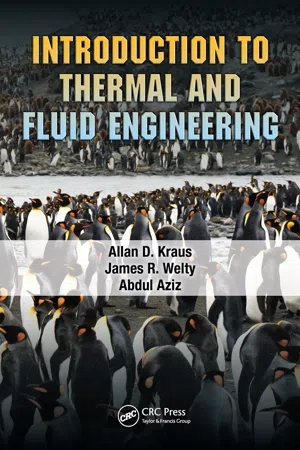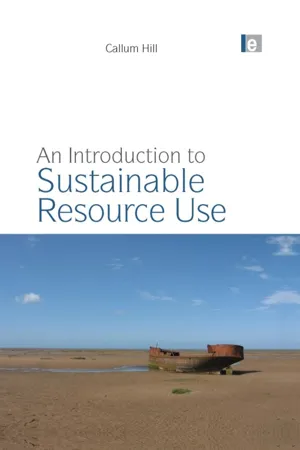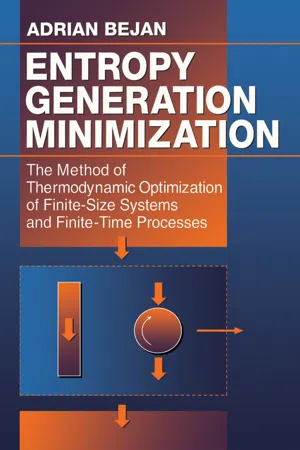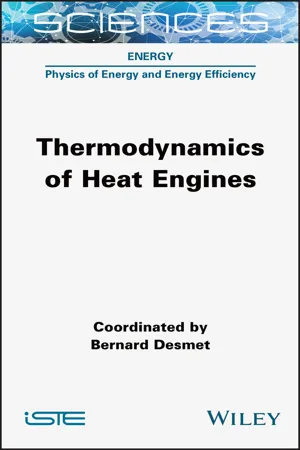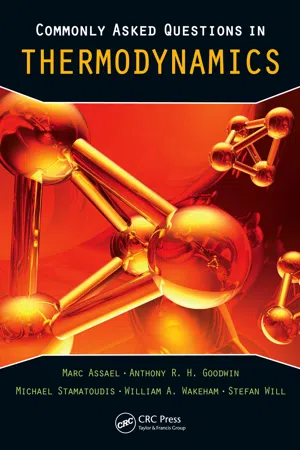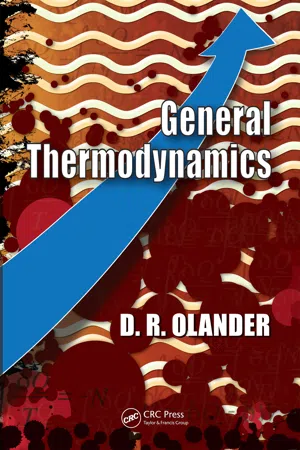Technology & Engineering
Engineering Thermodynamics
Engineering thermodynamics is the study of energy and its transformations within engineering systems. It focuses on the principles of energy transfer and conversion, as well as the behavior of materials and substances under different conditions. This field is essential for designing and optimizing energy systems, engines, and other mechanical devices.
Written by Perlego with AI-assistance
Related key terms
1 of 5
11 Key excerpts on "Engineering Thermodynamics"
- eBook - PDF
Towards an Environment Research Agenda
A Third Selection of Papers
- A. Winnett(Author)
- 2004(Publication Date)
- Palgrave Macmillan(Publisher)
Part IV Technology, Engineering and the Environment 175 8 Engineering Sustainability: Thermodynamics, Energy Systems and the Environment Geoffrey P. Hammond Summary Thermodynamic concepts have been utilized by practitioners in a variety of disciplines with interests in environmental sustainability, including ecology, economics and engineering. Widespread concern about resource depletion and environmental degradation are common to them all. It has been argued that these consequences of human development are reflected in thermodynamic ideas and methods of analysis; they are said to mirror energy transformations within society. The concept of ‘exergy’, which follows from the second law of thermodynamics, is viewed as providing the basis of a tool for resource and/or emissions accounting. It is also seen as indicating natural limits on the attainment of sustain- ability. The more traditional use of the exergy method is illustrated by a number of cases drawn from the United Kingdom energy sector: elec- tricity generation, combined heat and power schemes, and energy productivity in industry. This indicates the scope for increasing energy efficiency, and the extent of exergetic ‘improvement potential’, in each of these areas. Poor thermodynamic performance is principally the result of exergy losses in combustion and heat transfer processes. However, the application of such thermodynamic ideas outside the sphere of engineering is not without its critics. The link between the efficiency of resource utilization, pollutant emissions and ‘exergy consumption’ is real, but not direct. Methods of energy and exergy analysis are therefore employed to critically evaluate thermodynamic concepts as measures of sustainability. - Allan D. Kraus, James R. Welty, Abdul Aziz(Authors)
- 2011(Publication Date)
- CRC Press(Publisher)
2 Thermodynamics: Preliminary Concepts and Definitions Chapter Objectives • To briefly introduce the subject of thermodynamics. • To provide precise definitions of some of the working terms used in a study of thermodynamics. • To consider the dimensions and units that pertain to thermodynamics. • To examine density and its related properties. • To define pressure and consider how it is measured. • To define temperature and to present the zeroth law of thermodynamics. • To outline a problem-solving methodology. 2.1 The Study of Thermodynamics When most people think about thermodynamics, they think about the transfer of energy and the utilization of such energy transfer for the useful production of work. This often leads many engineering students in fields such as computer science and electrical or civil engineering to wonder why this particular subject is relevant to them. In reality, thermody-namics deals with much more than the study of heat or energy transfer and the development of work. Indeed, it deals with virtually all aspects of our lives, from the combustion pro-cesses that run our automobiles and produce our electric power in power plants to the refrigeration cycles that cool our beer, from the cryogenic pumping of liquids and gases in space to the distillation processes used to produce the gasoline that runs our automobiles. Thermodynamics is important to electrical engineers so that they can better understand that the limiting factor in the microminiaturization of electronic components is the rejec-tion of heat. It is important to civil engineers because a knowledge of thermal expansion and thermal stresses is requisite to the design of structures and to the computer scien-tists who need to thoroughly understand the systems that they are trying to model and develop.- eBook - ePub
- Callum Hill(Author)
- 2012(Publication Date)
- Routledge(Publisher)
2
Thermodynamics
(the science of energy and change)
Introduction
Thermodynamics is one of the most powerful tools at our disposal for the study of the sustainability of processes. Although a development that was associated with the invention of the steam engine, it has proved to be of much wider application in the fields of chemistry, ecology, biochemistry, cosmology and information theory. If we wish to understand anything about the sustainability of a process, it is clearly important to know about energy use, recycling and other facets concerned with the management or utilization of resources and it is thermodynamics that provides the basis for the answers to many of the questions. Although this book concerns physical resources and their exploitation, it is necessary to use energy in the processing of these materials and so it follows that we have to understand the properties of energy and how it interacts with matter.What is energy?
Energy is used to move things, to drive machinery, to provide heat and electricity, and to stay alive. Without energy there would be no change and time would not exist. But what exactly is it? For many years energy was seen as a mysterious force that acted upon matter and somehow gave it ‘life’ and it was given a name that reflected this idea, ‘vis viva’. Even now, much misunderstanding exists; it is common to see the words ‘energy’ and ‘power’ used interchangeably although they mean different things, or references to energy ‘consumption’, whereas energy is always conserved. There is no doubt that something is being consumed when we use energy and we shall examine later in this chapter what this something is. - eBook - PDF
Engineering Problem Solving
A Classical Perspective
- Milton C. Shaw(Author)
- 2001(Publication Date)
- William Andrew(Publisher)
Thermal Engineering 269 269 1.0 INTRODUCTION Important topics to be considered in this chapter are thermodynamics, thermal transformation systems, and heat transfer. Thermodynamics in-volves fundamental relationships between heat, work, and the properties of a system. It is concerned with the transformation of one form of energy into another and the basic laws that control such transformation. Of particular importance is the transformation of thermal energy into mechani-cal energy, which is the first step in the conversion of the energy associated with fossil fuels into electrical energy as discussed in Ch. 10. Thermal transformation systems are systems that transform thermal energy into mechanical energy. This includes steam power plants, steam engines, steam turbines, gas turbines, and internal combustion engines. Heat trans-fer is concerned with the transfer of thermal energy from one medium to another by: Radiation Conduction Convection 11 Thermal Engineering 270 Engineering Problem Solving: A Classical Perspective With radiation, heat is transferred by electromagnetic waves ema-nating from a hot body to a cold body where radiation waves are absorbed resulting in a temperature rise. Conductive heat transfer involves the passage of heat through a solid from a region of high temperature to one of lower temperature. Convective heat transfer involves the transport of thermal energy from a hot body to a fluid flowing across the hot body. 2.0 HISTORICAL BACKGROUND Before the 17 th century, little attention was given to thermal energy. The Phlogiston Theory of heat championed by Stahl (16601734) was the first generally accepted. This proposed that all combustible materials contain a massless material (phlogiston) that escapes on combustion. Some materials like sulfur were considered rich in phlogiston while others con-tained very little. - eBook - PDF
Entropy Generation Minimization
The Method of Thermodynamic Optimization of Finite-Size Systems and Finite-Time Processes
- Adrian Bejan(Author)
- 2013(Publication Date)
- CRC Press(Publisher)
1 THERMODYNAMIC CONCEPTS AND LAWS The subject of Engineering Thermodynamics revolves around two pivotal state-ments, the first and the second laws of thermodynamics. Both laws are old, relative to our lifetime experience, the first law being the product of a vehement debate started approximately 200 years ago. Because the objective of all introductory thermodynamics courses is to explain the meaning and usefulness of the two laws and their related concepts (Moran, 1989), in the present treatment it is assumed that the laws are known and accepted. However, in order to provide a common language and ground for the issues to be debated in this book, the basic concepts introduced in engineering through thermodynamics are reviewed in this chapter. The review is limited to the thermodynamics of a pure substance. 1.1 DEFINITIONS A key concept in thermodynamic analysis, often abused, is the concept of system. A thermodynamic system is the region or collection of matter in space that is selected for analysis. The concept of system requires the recognition of an envi-ronment, which is the space, or system, external to the system of interest. Separating the two systems is the system boundary (frontier), which, in general, is a real or imaginary surface delineating the contour of the system of interest. The system boundary may or may not possess special features that, as a matter of consequence, lead to a hierarchic ordering of thermodynamic systems for the purpose of analysis. For example, a boundary that is impermeable to mass flow defines a closed system. Naturally, in a closed system the matter (mass inventory) is conserved. On the other hand, a boundary that is permeable (has openings, ports) for mass transfer defines an open system. The flow of mass through the system boundary is only one of the three transfer effects (interactions) commonly encountered in engineering applications. The other two effects are heat transfer and work transfer. - eBook - PDF
Thermo and Fluid Dynamics
Recent Advances
- Dritan Hoxha(Author)
- 2019(Publication Date)
- Arcler Press(Publisher)
Thermo and Fluid Dynamics: Recent Advances 10 More specifically, Thermodynamics is important because: • It provides a mathematical framework to understand how energy transfer inside a system; hence help us to design, predict, and calculate the efficiency of better heat engine. • It gives a framework to predict the behavior of matter in different situation. • It gives a framework to predict if any reactions can happen at all. • It gave us the 2nd law which helps us understand the spontaneity of some process. Some describe it as the arrow of time. Hence thermodynamics is one of the few basic branch of science which gives us some notion of time. • People started to understand the universe in a deeper level (in atomic level) from calculation in classical thermodynamics even before they were able to see it in microscope. • All the rockstars in science have considered it very important. 1.4. A SHORT VIEW OF THE QUANTITIES INVOLVED IN THERMODYNAMICS a) Heat: Thermodynamics, is concerned with several properties of matter where the most important one is heat. Heat is the energy transferred between bodies or systems due to a temperature difference between them, according to many well-known scientists [5]. As it is a form of energy, heat, therefore, is conserved, i.e., it can neither be created nor destroyed [5]. However, it can be transferred from one place to another [5]. Furthermore, heat can be converted to and from other forms of energy. For instance, a steam turbine can convert heat into kinetic energy to make a generator work. On the other hand, this generator converts kinetic energy to electrical energy. Later, a light bulb converts this electrical energy to electromagnetic radiation (light), which, when absorbed by a rough, black, and dull surface, is converted back into heat [5]. b) Temperature : The amount of heat transferred by a substance depends on two factors: the speed and the number of atoms or molecules in motion of that substance [5]. - eBook - PDF
- Bernard Desmet(Author)
- 2022(Publication Date)
- Wiley-ISTE(Publisher)
1 Energy Conversion: Thermodynamic Basics Georges DESCOMBES 1 and Bernard DESMET 2 1 CNAM, Paris, France 2 INSA – HdF, Université Polytechnique Hauts-de-France, Valenciennes, France 1.1. Introduction We are interested here in the conversion of heat into mechanical work via machines using a fluid medium in a continuous flow, or functioning in a cyclic manner. This first chapter succinctly presents the main concepts of thermodynamic used in this context. For a more in-depth study, the reader may consult the specialized works of Borgnakke and Sonntag (2013), Feidt (2014), Foussard et al. (2021) and Çengel et al. (2019). Classical sign conventions will be used: the quantities of heat and work exchanged between a system and its exterior will be positive while they are received by the system. Work, quantities of heat and extensive state quantities – quantities of which the value is proportional to the quantity of matter of the system – will be denoted in uppercase when they refer to the whole system and in lowercase when they are expressed per unit mass. Therefore, W, Q, U, etc. refer to work exchange, heat, internal energy, etc. for the considered system, and w, q, u, etc. are the corresponding specific quantities. Thermodynamics of Heat Engines, coordinated by Bernard DESMET. © ISTE Ltd 2022. 2 Thermodynamics of Heat Engines 1.2. Principles of thermodynamics 1.2.1. Notion of a thermodynamic system In the strict sense of the term, a thermodynamic system or even a closed system does not exchange matter with its exterior. Its boundary is impermeable to the exchange of matter. In technical thermodynamics, we are interested more often in the equipment (heat exchangers, turbines, compressors, etc.) through which one or more fluids flow. Generally, we look for characteristics (pressure, temperature, mass flow rate, etc.) in the fixed sections located on either side of the component being studied and defined as the inlet and output of this component. - eBook - PDF
- Marc J. Assael, William A. Wakeham, Anthony R. H. Goodwin, Stefan Will, Michael Stamatoudis(Authors)
- 2011(Publication Date)
- CRC Press(Publisher)
1 1 Chapter Definitions and the 1 st Law of Thermodynamics 1.1 INTRODUCTION The subjects of thermodynamics, statistical mechanics, kinetic theory, and transport phenomena are almost universal within university courses in physical and biological sciences, and engineering. The intensity with which these topics are studied as well as the balance between them varies considerably by disci-pline. However, to some extent the development and, indeed, ultimate practice of these disciplines requires thermodynamics as a foundation. It is, therefore, rather more than unfortunate that for many studying courses in one or more of these topics thermodynamics present a very great challenge. It is often argued by students that the topics are particularly diffi cult and abstract with a large amount of complicated mathematics and rather few practical examples that arise in everyday life. Probably for this reason surveys of students reveal that most strive simply to learn enough to pass the requisite examination but do not attempt serious understanding. However, our lives use and require energy, its conversion in a variety of forms, and understanding these processes is intimately connected to thermodynamics and transport phenomena; the latter is not the main subject of this work. For example, whether a particular proposed new source of energy or a new product is genuinely renewable and/or carbon neutral depends greatly on a global energy balance, on the processes of its production, and its interaction with the environment. This analysis is necessarily based on the laws of thermodynamics, which makes it even more important now for all scientists and engineers to have a full appreciation of these subjects as they seek to grapple with increasingly complex and interconnected problems. This book sets out to provide answers to some of the questions that under-graduate students and new researchers raise about thermodynamics and sta-tistical mechanics. - Michael Clifford, Kathy Simmons, Philip Shipway(Authors)
- 2009(Publication Date)
- CRC Press(Publisher)
An Introduction to Mechanical Engineering: Part 1 232 ✔ By the end of this section you should understand that the second law of thermodynamics distinguishes between work and heat transfer and recognize that work transfer is the more valuable of these. This does not contradict the first law; energy transferred by one is indistinguishable from energy transferred by the other, and the principle of energy conservation is not violated. There are, however, limits on how efficiently heat can be drawn from a source and converted into work output using a system which operates in a cycle: ✔ As a consequence of the second law, a system operating in a cycle and producing work output must be exchanging heat with at least two reservoirs at different temperatures. If a system is operating in a cycle while exchanging heat with only one reservoir, if a net transfer of work occurs it must be to the system. Work can be converted continuously and completely into heat, but heat cannot be converted completely and continuously into work. The efficiency of a heat engine designed to produce a net work output is defined as n h et ea w t o s r u k p o p u li t e p d ut Q W 1 ✔ Note that it is the heat supplied that we are trying to convert to work output, not the net heat transfer. ✔ Efficiency is the measure of success in achieving this. The highest possible efficiency that can be achieved is the Carnot efficiency. ✔ carnot 1 T T 2 1 ✔ The existence of entropy is a corollary of the second law. It is important to remember that entropy is a property, like pressure or temperature, but also that it provides a measure of order and irreversibility. It is not conserved, like mass of energy, and the entropy of the universe is increasing continuously as the result of the myriad irreversible processes taking place: an implication of the Clausius inequality is that entropy is created during an irreversible process; this may result in an increase in entropy of the system and/or of the surroundings.- eBook - PDF
- Mike Tooley, Lloyd Dingle(Authors)
- 2010(Publication Date)
- Routledge(Publisher)
KEY POINT A thermodynamic system is essentially a thermodynamic substance surrounded by an identifiable boundary Thermodynamic systems Thermodynamic systems may be defined as particular amounts of a thermodynamic substance, normally compressible fluids such as vapours and gases, which are surrounded by an identifiable boundary. We are particularly interested in thermodynamic systems that involve working fluids (rather than solids) because these fluids enable the system to do work or have work done upon it. Only transient energies in the form of heat ( Q) and work ( W) can cross the system boundaries, and as a result there TYK 5.20 1. State the units and give the sign convention for heat flowing into and out of a system. 2. Write down the symbol for a quantity of heat energy. 3. Explain the nature of the two mechanisms of heat transfer by conduction. 4. What is the essential difference between heat transfer by convection and heat transfer by radiation? 5. With respect to engineering, why is the study of thermodynamics important? T e s t y o u r k n o w l e d g e TYK Mechanical Principles and Applications 427 UNIT 5 will be a change in the stored energy of the contained substance (working fluid). The property of a working fluid is an observable quantity, such as pressure, temperature, etc. The state of a working fluid may be defined by any two unique and independent properties. Boyle’s law defines the state of the fluid by specifying the independent thermodynamic properties of volume and pressure. A thermodynamic system must contain the following elements: ● a working fluid or substance, that is the matter, which may or may not cross the system boundaries, such as water, steam, air, etc. ● a heat source ● a cold body to promote heat flow and enable heat energy transfer ● system boundaries, which may or may not be fixed. Some of the more common properties (with units) that are used to define the state of the working matter within a thermodynamic system are shown in Table 5.4. - eBook - PDF
- Donald Olander(Author)
- 2007(Publication Date)
- CRC Press(Publisher)
109 4 Heat Engines, Power Cycles, and the Thermodynamics of Open Systems 4.1 HEAT ENGINES In Section 1.9, it was noted that the first law regards heat and work as completely interchangeable; if a certain number of Joules of heat added to a system increases the internal energy of a body by, say, Δ U , the same number of Joules of work performed on the body would produce the same Δ U . In addition, work can be completely converted to heat, as everyday experience with friction attests. However, the reverse is not true; heat cannot be completely transformed into work. This limitation, which is a consequence of the second law, is best demonstrated by studying the properties of heat engines . A heat engine is a system operating in a cycle that receives heat from a high-temperature source (called a thermal reservoir) and produces useful work. However, since the efficiency of conversion must be less than 100%, some of the input heat is rejected to a cold reservoir. Figure 4.1 shows a schematic of a heat engine/heat pump and their associated thermal reservoirs. The reservoirs supply or receive heat without alteration of their temperatures. Heat flows in the reservoirs are reversible whether or not the engine is. FIGURE 4.1 A schematic of a heat engine or heat pump. The heat pump is a heat engine running in reverse. Hot Reservoir T H Cold Reservoir T L Heat Pump Heat Engine Cold Reservoir T L Hot Reservoir T H W W Q H Q L Q L Q H 110 General Thermodynamics The circle with the arrows in Figure 4.1 is a shorthand representation of the heat engine. It is intended to signify that the working substance (a fluid such as an ideal gas or water) moves through many thermodynamic states in a never-ending cyclic process. The detailed structure of the heat engine can vary greatly, but the simplest version contains the following four steps: 1. One in which heat is absorbed isothermally from the high-temperature reservoir. 2. The next, in which work is produced adiabatically.
Index pages curate the most relevant extracts from our library of academic textbooks. They’ve been created using an in-house natural language model (NLM), each adding context and meaning to key research topics.

